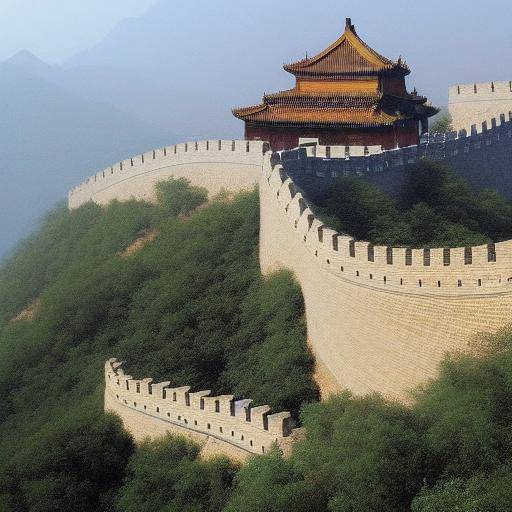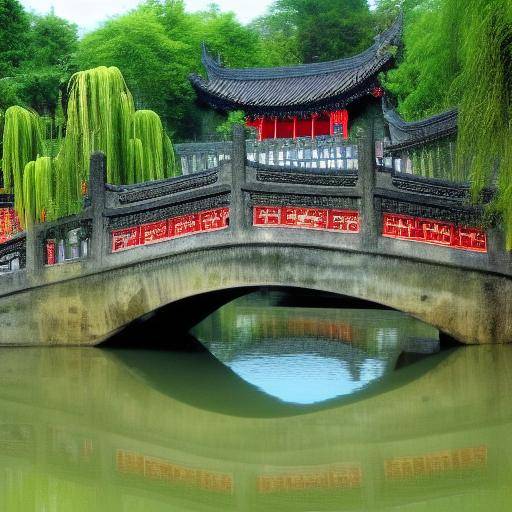
Introduction
The Great Wall of China, one of the most iconic architectural wonders of history, has captivated generations with its greatness and unparalleled engineering. In this article, you will enter into history, cultural significance, contemporary challenges and future prospects of this wonder. Discover how the Great Wall not only symbolizes the greatness of China, but is also a testimony of human ingenuity and untiring determination. Continue reading to explore its mysteries, historical impact and relevance today.
History and Background
The construction of the Great Wall of China, known as "The Great Wall", began more than two thousand years ago during the Qin dynasty. This monumental structure intended to protect the Chinese empire from barbaric incursions. Throughout the centuries, the wall spread and strengthened, becoming one of the greatest architectural exploits of humanity. Key events, such as the addition of new sections by different dynasties, confirm the cultural, military and political symbolism of this gigantic construction.
The First Steps
The Great Wall China originated with the unification of China by the first emperor, Qin Shi Huang, in 221 BC. The construction was an answer to the constant threats of the nomadic peoples of the north. The wall began as a series of earth walls and sticks, which later expanded and fortified with bricks and stone under the subsequent dynasties.
Evolution and Expansion
Over the centuries, the wall experienced significant expansions during the Ming and Qing dynasties, with the addition of watchtowers and fortresses to strengthen its defensive function. The architectural complexity and methods of construction employed are testimony to the ingenuity and technical skill of former Chinese builders.
Historical and Cultural Relevance
The Great Wall China transcends its defensive function and becomes a cultural icon, representing Chinese resistance, ingenuity and identity. Its influence extends to literature, art and oral tradition, forming an integral part of China's historical and spiritual legacy.
Deep analysis
Contemporary Challenges
Despite its historic grandeur, the Great Wall China faces modern challenges, such as natural erosion and the pressure of mass tourism. The sustainability and conservation of this monumental structure represent a contemporary dilemma, where preservation must be balanced with accessibility and tourist promotion.
Cultural and Tourist Impact
The Great Wall of China is not only a historic monument, but also a world-renowned tourist destination. Its importance as a cultural heritage of humanity attracts millions of tourists every year. This poses the challenge of sustainably managing the tourist flow to preserve both the integrity of the wall and the visitor's experience.
Futures
The Great Wall China still continues its journey through human history. In the modern era, it has become a symbol of global collaboration, serving as a cultural bridge and witness of interconnection between nations. The proper conservation, research and promotion of the Great Wall will represent a continuing challenge in the international landscape.
Comprehensive review
Contemporary applications
The cultural and historical relevance of the Great Wall China has inspired modern adaptations in architecture and design. Its structure and symbolism have been used as a source of inspiration in contemporary architectural projects and infrastructure, demonstrating its lasting legacy.
Outlook of Experts
The experts in history and archaeology offer a valuable insight into the conservation and cultural significance of the Great Wall of China. Their views enrich the understanding of the importance of preserving this unique heritage for future generations.
Comparative analysis
Great Wall China vs. Other Historic Monuments
Compared to other historical monuments in the world, the Great Wall of China stands out for its magnitude, architectural complexity and symbolic wealth. Through this comparative analysis, it highlights its uniqueness and its impact on world history.
Synergies Between Historical Monuments
The cultural and symbolic interaction between the Great Wall of China and other historical monuments reveals profound connections, enriching the understanding of the collective heritage of mankind. Exploring these synergies promotes a deeper appreciation of cultural diversity and historical legacy.
Practical Tips and Accessible Recommendations
Visitor Experience
When visiting the Great Wall of China, it is important to plan ahead to maximize this unique experience. It is recommended to investigate the different sections of the wall, consider the less influx schedules and respect the conservation standards.
Personal impact
Exploring the Great Wall of China not only provides a historical and cultural context, but also inspires a deep sense of wonder and appreciation for human ingenuity. Taking this opportunity to reflect on its global significance can enrich the experience of visitors.
Conclusions and FAQs
Conclusion
The Great Wall of China stands as an indelible emblem of history, culture and human engineering. His legacy will endure as a testimony of human capacity to face immeasurable challenges. As we explore its historical, contemporary and future dimensions, we renew our admiration for this marvel of engineering.
Frequently asked questions
1. What is the total length of the Great Wall China?
The total length of the Great Wall of China is approximately 21,196 kilometres, covering its different sections.
2. At what time was the Great Wall China built?
The construction of the Great Wall China began in the third century BC during the Qin dynasty.
3. What is the main purpose of the Great Wall of China today?
Today, the Great Wall of China has become an important tourist attraction and a cultural and heritage symbol of China.
4. What are some of the current challenges facing the Great Wall China?
The Great Wall China faces challenges of conservation, preservation and management of mass tourism.
5. What is the impact of the Great Wall of China on China's cultural identity?
The Great Wall China is a symbol of the cultural and historical identity of China, representing the resistance and ingenuity of the Chinese people over the centuries.
6. What recommendations can be followed when planning a visit to the Great Wall of China?
When planning a visit to the Great Wall of China, it is advisable to investigate the various sections, consider lower inflow schedules and respect conservation standards.
With an imposing past, challenging present and captivating future prospects, the Great Wall China remains an inexhaustible source of admiration and astonishment. His greatness transcends time and space, leaving an indelible mark on the history of humanity.



